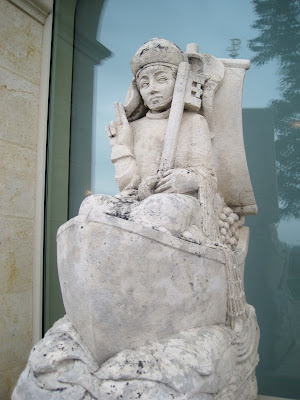After lunching on lemony scallops in a natural wine bar in Paris, we arrived at the impressive Bollinger HQ in Aÿ, made more magnificent by a bright blue, cloudless sky. Founded in 1829, the company is one of the last Champagne houses to still be family-owned, remaining under the watchful eye of Madame Lily Bollinger from 1941-1971. The majority of the grapes that go into Bollinger's cuvées come from Grand Cru and Premier Cru villages, as we were soon to find out...
Dropping our bags off, we hopped in a 4x4 and were taken on a tour of the Bollinger vineyards. Unusually in Champagne, the company owns 60% of its vineyards, 60% of which are planted with Pinot Noir and 40% with Chardonnay, as Bollinger favours the richness and body Pinot Noir brings to the blend. The little house you can see in the distance is for the grape growers and pickers to take shelter in when it rains. They also serve as a water source, as each are home to a well.
Striking a pose in front of a very special vineyard: Clos des Chaudes Terres, meaning the clos of warm earth – a walled, ungrafted, 100% Pinot Noir vineyard worked by hand behind Bollinger HQ in Aÿ, which, along with the neighbouring Clos St Jacques, nurture the Pinot grapes for the incredibly special Bollinger Vieilles Vignes Français, of which only 2,000 bottles are made in exceptional vintages.
No mention of Bollinger would be complete without a hat tip to James Bond. At the entrance to the house behind glass is one of the famous Bollinger Bond Walther PPK bullet Champagne coolers made to celebrate the launch of
Quantum of Solace. Over dinner, president Jérôme Philipon admitted that Bollinger's association with the secret agent was helping to boost sales of the brand in Asia, and revealed that the company will launch a couple of Bond-branded bottlings this October to coincide with the
Skyfall premiere in London.
From bullets to cars – I spotted this rather fetching Bollinger branded Mini in the Bolly HQ car park.
Having watched Bollinger's award winning master cooper in action, noisily hammering one of their French oak barrels into shape, I took a moment to enjoy the sunshine streaming into the courtyard.
Later that day, we were treated to dinner at Madame Bollinger's house, which has been kept exactly the same as when she lived in it, kicking off the evening with a chilled glass of Grand Cuvée. If you look closely, you'll spot our affable host, Elizabeth Ferguson of Mentzendorff.
The scene is set for our night of revelry
I spotted a pair of wild boar heads proudly mounted on the drawing room wall – legend has it that wild boar still roam the forests of Champagne. I failed to spot any on my visit, but I did hear an ominous rustling coming from the woods next to Bollinger's highest vines.
Kate Powell, aka The Wine Chick, got a shock when she lifted what she thought was a prayer chair prettifying Madame Bollinger's drawing room and found an adult potty – curiouser and curiouser.
Bollinger president Jérôme Philipon holds court over dinner with his ebullient harem. He can be seen pouring a bottle of the near-mythical Vieilles Vignes 1997, which he presented as a blind tasting.
Our feast kicked off in earnest with a delectable starter of crab cake in a yuzu (Japanese citrus) and coriander sauce decorated with salad leaves and an edible yellow pansy. Such a wonderful start to the meal, the yuzu lifted the crab and gave the dish a lovely freshness, while the accompanying La Grande Année Rosé 2004 had its own floral characterisitcs, along with notes of wild strawberry and mint.
Next up were silky, crispy slithers of red mullet in a creamy sauce paired with La Grande Année 2002. The richness of the cream sauce paired wonderfully with the rich, biscuity 2002 - one of the greatest Champagne vintages in living memory.
Dessert was a raspberry tart on a sesame biscuit base with vanilla mousse and a strawberry macaroon. Exquisitely presented, the textured biscuit base complemented the sharp tang of the raspberries, which in turn paired beautifully with the summer fruit-filled NV Rosé.
My food and wine pairing of the night however, was the Bernard Anthony aged Comté with Bollinger R.D. 1995. Words cannot do justice to the majesty of the pairing, the grainy, nutty, almost toffee-like Comté holding its own against the might of the rich, intense, hazlenut-filled R.D. Both the cheese and the Champagne displayed an almost Sherry-like sweetness and complemented each other so cleverly. It remains my ultimate food and wine match, which I doubt can ever be bettered.

Our final treat was a glass of the super rare Bollinger Vieilles Vignes Françaises 1997, which Jérôme was incredibly kind to open. I'd dropped a large number of hints about my desire to try it on Twitter, though never believed I actually would. The nose was unlike any Champagne I've ever tried: savoury, earthy, intense and truffly; the Pinot Noir really showed through. On the palate, it seemed more like a still wine and had a real vinous character, the earthiness remaining, along with the slight presence of tannin and an incredibly long and pleasing nutty finish. Drinking it at Madame Bollinger's house only heightened the enjoyment of this rough diamond.
After all that excitement, it was time for bed, and what more fitting way to sleep, having been treated like a princess, than in a four poster bed. I could get used to being under Bollinger's wing. Waking up the next morning, I had to be dragged onto the Eurostar back to London.























































